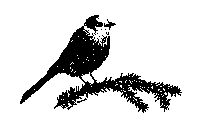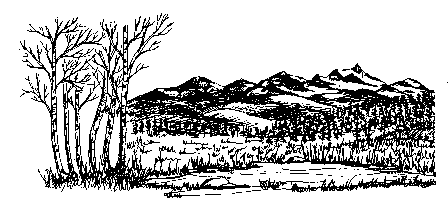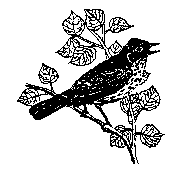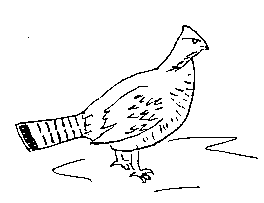Lessons & Units
A database
of lessons and units searchable by content and cultural standards,
cultural region and grade level. More units will be available soon.
You can use Acrobat Reader to look at the PDF version of the Cover
Sheet
for the Units and Self-Assessment
for Cultural Standards in Practice.
BIRDS
|
Lesson 3 Identifying Local
Birds
|

|
Objectives:
1) Students will develop their powers of observation and
their ability to make inferences by looking for birds and bird
signs.
2) Students will collect and interpret data about local birds
and identify birds both by learning the practices of their elders
and by use of field guides and other written sources.
3) Students will name and cite identifying characteristics of
at least 10 birds which are found locally.
Notes on Bird Identification
Birds were a very important part of the natural world for Interior
Athabascans in times past. Game birds formed a necessary part of
their diet and in times of starvation even the smaller birds helped
the people survive. Many birds had other important functions as well.
(See Lesson 7). For these reasons and also because birds were
believed at one time to have had human form, they were highly
respected and the indigenous people of Alaska had a detailed
knowledge of the birds and their habits.
Do not be surprised, however, if elders and other community
members do not know the local birds by the names found in bird books.
They may call them by a descriptive name in English such as "big-eye
bird" or "black chicken" or they may know them only by their Native
names.
When working with elders to identify birds, students should
have
not only a picture of the bird but also know something about its
behavior and where it is found. Many times elders did not have to see
a particular bird to tell what it was. They often identified a bird
by what it did - "it's always
scratching around" or by its song -"it sounds like a bell", or by where and when it was seen - "first you hear it way back in
the woods and then it comes closer and closer to the river as the
fish come." Often the Native names were descriptive and told
something about the bird.
Occasionally it may be difficult to match the elders
identification of a bird with what is found in a field guide. Trying
to figure out what a certain kind of bird is can be like solving a
puzzle. Sometimes the actual "Western" name is not all that
important. Working with elders on these activities will teach
students far more that just the identity of certain birds.
|
Materials:
|
colored pictures or photographs of a few local birds.
sketches of birds for students to color
|
Activities:
1) As an introduction, show the class
sketches or photographs of some common local birds and have
students name them. Brainstorm to find out the names of other
local birds which students know.
2) Take a walk with elders or other community members
looking for birds and bird signs (see sample of "bird signs").
Ask students to make inferences from their observations of bird
signs. i.e. what birds live in the area even though you may not
have seen them.
Find out what names the elders have for the birds and how
they identify them. Learn the local Native names and the
translation of each as it will probably tell something about
the bird. (see example)
Make a class list of birds you have identified.
3) Brainstorm all the different ways a bird can be
identified: color, size, habitat, behavior, song. (Alaska 's
Birds, pg. 4-6) Remember also the shape of bill, feet,
wings and tail as noted in Lesson 1. Discuss how the elders
most commonly identified birds, not so much by sight as by
sound, behavior and location.
Begin making a large chart for all the birds on your class
list. Record as many of the characteristics as you can for
each.
4) Discuss the relative size of a raven, a gray jay
and a chickadee. Take another walk using the "Field Notes" sheet to
record information on each bird you see. Add this information
to your chart.
Now look up each bird in a field guide and compare the
information about size, color and habitat/range to your own
notes. Add any new information to your chart.
5) Draw and/or color pictures of the birds which are
found locally. Consult a bird book if necessary for correct
coloration.
Make your own local bird book either individually, in groups
or as a class. Be sure to include a colored picture, a
description of the bird and the Native name for each.
6) Bird Classification: Birds as well as other living
things can be classified in many different ways. If you look in
a field guide such as Western Birds, you will find dozens of
categories and subcategories.
The Native people of Alaska had their own systems based on
the bird characteristics and on where and when they saw the
birds. For example, the Dena'ina had categories such as Winter
Birds and Summer Birds, Climbing Birds, Scavengers and
Nomadics.
Discuss classification with the class and set up a few
simple categories of your own. Then have each student divide
the birds on the class list into these categories. Discuss the
results and make a class chart to show where each bird
fits.
7) Bird Population: The local population of some will
vary with the seasons but students can learn how to estimate
and calculate and consider variables by doing this
activity.
Have the class do a bird count at the same hour, for the
same length of time, and in the same area on three different
days. How many of each species do they count? Set up a chart to
show the ratio of one species to another. (You could limit this
project to just certain birds such as raven, jay, chickadee.)
Then estimate what the population might be in a much larger
area.
Speculate on the accuracy of such a study. What are the
variables to consider?
from ALASKA'S BIRDS
HOW TO IDENTIFY
BIRDS
Almost 400 kinds of birds can
be found throughout Alaska. Does it seem impossible to ever identify
so many birds? Just by learning to recognize a few characteristics,
many birds can be easily identified.
Color: The color of a
bird is important to notice because birds come in all different
colors, but birds of the same species can be different colors. Many
birds change colors in the fall and spring. Male birds are usually
more brightly colored than females, and young birds are often
different colors than their parents. These color variations may cause
confusion in identification. Although color is important for
identification, other characteristics must also be noted. In addition
to color, try to note the following things about each new bird you
see.
Size: When you see a new
bird, note how big it is. Is it a large bird like a raven, or is it a
medium-sized bird like a gray jay? Is it a small bird like a
chickadee?

Common Raven |

Gray Jay |

Black-capped Chickadee |
from ALASKA'S BIRDS
Habitat: Just
remembering where you see a bird will help you identify it. Was it on
a mudflat, by a pond, in a stream, in a spruce tree, in a birch
forest, or on the tundra? Was it on a rocky beach or a sandy
beach?

Behavior: Notice what a
bird is doing when you see it. For example, kingfishers perch on a
branch over water, then suddenly dive straight into the water for
fish and frogs. Flocks of swallows often dip and dive over water to
catch insects. Bohemian waxwings often flock together and feed on
berries. Flycatchers flit upward from a branch, snatch an insect,
then loop back to the same perch. Grebes, loons, mergansers, and
puffins dive under water to catch fish. Hawks and eagles often soar.
Woodpeckers can be identified by their habit of pecking on trees.
They also fly in a certain pattern.

|

|
Songs: Songs
can be used to locate and identify birds. Some similar birds
have very different songs. For example, alder flycatchers
look so much like Hammond's flycatchers that you probably
couldn't tell them apart if their songs were not so
different. When you hear a bird singing, look for it. Birds
often sing from places where they can be easily
seen.
|
Bird Name
Table
|
COMMON NAME
|
ALASKA NATIVE
NAME
|
ALASKA NATIVE
LANGUAGE
|
|
1. Horned Grebe
|
toqa' vichidi
"red-necked grebe's younger
brother"
|
Ingalik
Athabaskan
|
|
2. White-fronted
Goose
|
K'ldot'aa-gga'
"bare-beak" ref
|
Koyukon
Athabaskan
|
|
3. Mallard
Derived from old French, it refers "to
maleness".
|
Keenaadachuh
"flies straight up in the
air"
|
Tlingit
|
|
4. Scaup
Refers to birds that feed on "scamps"
or "scalps" (an early name for scallops).
|
Tontseedla
"stays in water"
|
Koyukon
Athabaskan
|
|
5. Harlequin Duck
A "harlequin" is the name of a
character in old Italian comedies who wore a mask and
colorful tights.
|
taa'sa hut'aana
"lives in whitefish lakes"
|
Koyukon
Athabaskan
Ingalik
Athabaskan
|
|
6. Bald Eagle
The white head of this eagle appeared
bald.
|
ch'aak
imitates the sound made
|
Tlingit
|
|
7. Ptarmigan
|
dibaaga
imitates sound made by willow
ptarmigan
|
Koyukon
Athabaskan
|
|
8. Lesser Golden
Plover
|
bibidisis
"bear belly"
|
Koyukon
Athabaskan
|
|
9. Yellowlegs
|
dzolnolga
long legs
|
Koyukon
Athabaskan
|
|
10. Bonaparte's Gull Charles
Bonaparte, Napoleon's younger brother, was an American
ornithologist.
|
Veelzina
"black head"
|
Athabaskan
Koyukon
|
|
vilthelzring
"his head is black"
|
Ingalik
Athabaskan
|
from ALASKA'S FORESTS & WILDLIFE
BIRD SIGNS
CHART
|
Bird
|
Signs
|
|
Signs Left by Many
Birds
|

Feathers |

Stick or Grass Nests
|
|
|
Grouse
|
|

|
Grouse make 3-toed
tracks on solid snow or wet soil, but in deep soft
snow they make a like a ditch in the snow. Their
droppings seem dry and are shaped like hit worms.
Listen for their hooting or drumming
calls.
|
|
|
Woodpeckers
|
|

|
Listen for tapping
or drumming sounds. Look on live and dead trees for
small or large holes that look like something
drilled into the bark of the tree. Also look for
flakes of bark around the base of trees.
|
|
|
Raven
|
|

|
Droppings and
tracks around a dead animal.
Hoarse croaking
sounds.
|
|
|
Hawks and Owls
|
|

|
Hawks and owls regurgitate
pellets of fur, feathers, and other indigestible
hits of the prey. These pellets are cleaned of all
meat, so that they smell and feel clean.
|
|
|
Songbirds
|
|

|
Listen for twittering, chirping,
or other calls and songs.
|
|
BIRDS TO COLOR - Lesson
3
Bird pictures to color are fairly easy to find. There are several
different Alaska coloring books on the market which have pictures of
some of the birds which might be on your local list. The best
collection is found in the Birds of Alaska Coloring Book,
published by the Arctic Audubon Society in 1981 and now available
from the Alaska Natural History Association office in Anchorage,
phone 907-274-8440.
The Iditarod Area School District had three small coloring books
prepared for use in the district's Bilingual/Bicultural Program. In
addition to just coloring the pictures students can use the booklets
for identification of birds and to record the Native name and other
information. These books can then be taken home to share with the
student's family. The birds depicted are as follows:
First Bird Book - robin, camp robber (gray jay), swallow, woodpecker, raven,
spruce grouse, ruffed grouse
Water Birds - loon, gull, crane, duck, Canada goose,
swan
Winter Birds - chickadee, junco, white crowned sparrow,
redpoll, pine grosbeak, snow bunting
These are available from IASD, P.O. Box 90, McGrath, AK 99627

FIELD NOTES
Size:
______________________________________________
It is bigger or smaller than a
chickadee?
It is bigger or smaller than a gray
jay?
It is bigger or smaller than a
common raven?
Color:
_____________________________________________
crown
______________________________________
nape
_______________________________________
back
_______________________________________
wings
______________________________________
rump
_______________________________________
tail
_________________________________________
belly
_______________________________________
breast
______________________________________
bill
________________________________________
legs and feet
_________________________________
Behavior - What is it doing?
____________________________
___________________________________________________
___________________________________________________
Habitat - Where is it located?
___________________________
___________________________________________________
___________________________________________________
Shape - Draw a picture to
answer each of the following questions.
What is the bird's
shape?
What does its bill look
like?
What do its legs and feet look
like?
What shape are its
wings?
What does its tail look
like?
Song - Is it singing? What
does it sound like?
___________________________________________________
___________________________________________________
|
Handbook
for Culturally Responsive Science Curriculum by Sidney Stephens
Excerpt: "The information and insights contained in this document will be
of interest to anyone involved in bringing local knowledge to bear in school
curriculum. Drawing upon the efforts of many people over a period of several
years, Sidney Stephens has managed to distill and synthesize the critical ingredients
for making the teaching of science relevant and meaningful in culturally adaptable
ways." |